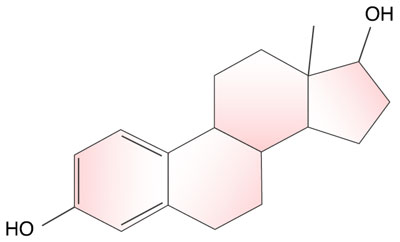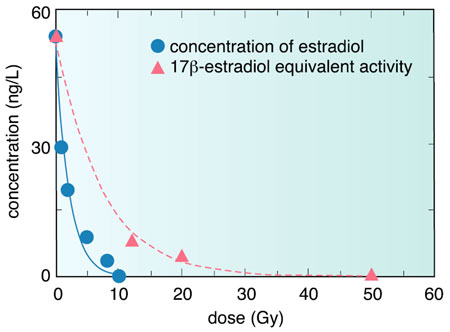6-2 |
Guard Aquatic Creatures from Feminization |
 |
||
|
 |
||
|
|
Endocrine-disrupting chemicals are contained in waste water released from stockbreeding farms and chemical factories. Such chemicals show similar estrogen activity to that of female hormones produced in the bodies of aquatic creatures such as carp. This is the source of the generative hazard known as 'feminization'.
17beta-estradiol, the female hormone with the strongest activity (its chemical structure is shown in Fig. 6-3), is released naturally by both humans and domestic animals. It has a biological impact even at very low concentrations (a few ng/L). At present, the amount of this hormone released into rivers is not regulated, because of the obscure relationship between the experimental data on humans and fish, and its monitoring in river water has been continued in order to avoid widening the area considered to be polluted by 17beta-estradiol. There has been no effective technology to treat such endocrine-disrupting chemicals up to now. For instance, collection technology using filters or other methods is difficult to be employed for pollutants at such very low concentrations, and UV light exposure technology is not applicable to suspended solutions or mass treatment of waste water. We have developed a technology to eliminate the endocrine-disrupting activity of 17beta-estradiol using reactive species, e.g. free radicals, induced in water by 60Co gamma-ray irradiation. This technique works through the breaking of chemical bonds and consequent destruction of molecular structures relating to the activity. This method has been developed to treat waste water at a water purification plan just before releasing it into the river, and is also expected to be applied to the decomposition of other toxic organic substances and to the sterilization of water. For the determination of optimum treatment conditions, 17beta-estradiol is prepared at 6 to 60 times higher concentration than the threshold for showing biological effects. The activities of 17beta-estradiol solutions are evaluated before and after gamma-ray irradiation using ELISA (Enzyme-Linked Immunosorbent Assay) method, which is based on an enzyme reaction. Shown in Fig. 6-4 are the 17beta-estradiol concentration ( The above fundamental study is being continued to improve the efficiency of treatment based on laboratory-scale results and will proceed to development of an optimum full-scale waste water treatment process. The development of decomposition and elimination technology for non-natural chemicals which show activity in waste water released from chemical factories, e.g. alkylphenols, is also in progress. |
|
Reference
A. Kimura et al., Radiation-Induced Decomposition of Trace Amounts of 17beta-Estradiol in Water, Radiat. Phys. Chem., 69(4), 295 (2004). |
| Select a topic in left column |
|
|
Persistent Quest Research Activities 2004
Copyright (C) Japan Atomic Energy Research Institute |